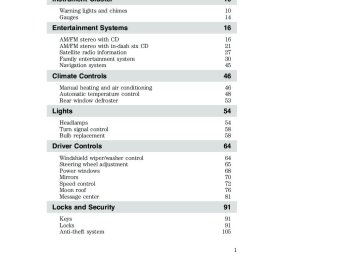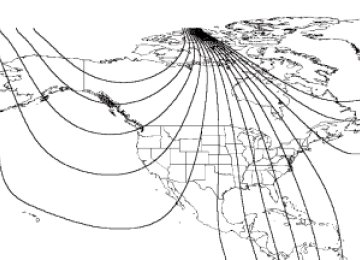- Download PDF Manual
-
2007 Five Hundred (500) Owners Guide (post-2002-fmt) USA (fus)
Maintenance and Specifications
3. The fuel cap may not have been securely tightened. See Fuel filler cap in this chapter. 4. Driving through deep water—the electrical system may be wet. These temporary malfunctions can be corrected by filling the fuel tank with good quality fuel, properly tightening the fuel cap or letting the electrical system dry out. After three driving cycles without these or any indicator should stay off other temporary malfunctions present, the the next time the engine is started. A driving cycle consists of a cold engine startup followed by mixed city/highway driving. No additional vehicle service is required. If the available opportunity. Although some malfunctions detected by the OBD-II may not have symptoms that are apparent, continued driving with the economy, reduced engine and transmission smoothness, and lead to more costly repairs.
indicator remains on, have your vehicle serviced at the first
indicator on can result in increased emissions, lower fuel
Readiness for Inspection/Maintenance (I/M) testing Some state/provincial and local governments may have Inspection/Maintenance (I/M) programs to inspect the emission control equipment on your vehicle. Failure to pass this inspection could prevent you from getting a vehicle registration. Your vehicle may not pass the I/M indicator is on or not working properly (bulb is burned test if the out), or if the OBD-II system has determined that some of the emission control systems have not been properly checked. In this case, the vehicle is considered not ready for I/M testing. If the need to be serviced. Refer to the On board diagnostics (OBD-II) description in this chapter. If the vehicle’s engine or transmission has just been serviced, or the battery has recently run down or been replaced, the OBD-II system may indicate that the vehicle is not ready for I/M testing. To determine if the vehicle is ready for I/M testing, turn the ignition key to the ON position indicator blinks for 15 seconds without cranking the engine. If the eight times, it means that the vehicle is not ready for I/M testing; if the I/M testing.
indicator stays on solid, it means that the vehicle is ready for
indicator is on or the bulb does not work, the vehicle may
266
2007 Five Hundred (500) Owners Guide (post-2002-fmt) USA (fus)
Maintenance and Specifications
The OBD-II system is designed to check the emission control system during normal driving. A complete check may take several days. If the vehicle is not ready for I/M testing, the following driving cycle consisting of mixed city and highway driving may be performed: 15 minutes of steady driving on an expressway/highway followed by 20
minutes of stop-and-go driving with at least four 30-second idle periods. Allow the vehicle to sit for at least eight hours without starting the engine. Then, start the engine and complete the above driving cycle. The engine must warm up to its normal operating temperature. Once started, do not turn off the engine until the above driving cycle is complete. If the vehicle is still not ready for I/M testing, the above driving cycle will have to be repeated.POWER STEERING FLUID Refer to the scheduled maintenance information for the service interval schedules. 1. Start the engine and let it run until it reaches normal operating temperature (the engine coolant temperature gauge indicator will be near the center of the normal area between H and C). 2. While the engine idles, turn the steering wheel left and right several times. 3. Turn the engine off. 4. Check the fluid level in the reservoir. It should be between the MIN and MAX lines. Do not add fluid if the level is in this range. 5. If the fluid is low, add fluid in small amounts, continuously checking the level until it reaches the range between the MIN and MAX lines. Be sure to put the cap back on the reservoir. Refer to Maintenance product specifications and capacities in this chapter for the proper fluid type.
267
2007 Five Hundred (500) Owners Guide (post-2002-fmt) USA (fus)
Maintenance and Specifications
BRAKE FLUID The fluid level will drop slowly as the brakes wear, and will rise when the brake components are replaced. Fluid levels between the “MIN” and “MAX” lines are within the normal operating range; there is no need to add fluid. If the fluid levels are outside of the normal operating range the performance of the system could be compromised; seek service from your authorized dealer immediately.
TRANSAXLE FLUID
Checking automatic transaxle fluid—CVT transaxle Do not use supplemental transaxle fluid additives, treatments or cleaning agents. The use of these materials or transaxle fluids other than the recommended fluid, may affect transaxle operation and result in damage to internal transaxle components. Refer to your scheduled maintenance information for scheduled intervals for fluid changes. Your transaxle does not consume fluid. However, the fluid level should be checked if the transaxle is not working properly, i.e., if the transaxle slips, takes more than a couple of seconds to engage into Drive/Reverse or if you notice some sign of fluid leakage. It is recommended that an authorized dealer check fluid level and add fluid if required. If your transaxle has a low fluid condition sufficient to affect proper operation the transaxle control module will send a signal to illuminate the As long as the transaxle engages normally to drive or reverse, it is safe illuminates the vehicle should be taken to your to drive but if the authorized dealer for evaluation as soon as possible.
on the instrument panel.
268
2007 Five Hundred (500) Owners Guide (post-2002-fmt) USA (fus)
Maintenance and Specifications
If your transaxle does not engage normally, do not attempt to drive. The vehicle should be towed to your authorized dealer for evaluation.
Checking 6–speed automatic transmission fluid (if equipped) Refer to your scheduled maintenance information for scheduled intervals for fluid checks and changes. Your transaxle does not consume fluid. However, the fluid level should be checked if the transaxle is not working properly, i.e., if the transaxle slips or shifts slowly or if you notice some sign of fluid leakage.
Checking automatic transmission fluid at operating temperature (158°F-176°F [70°C-80°C]) Automatic transmission fluid expands when warmed. To obtain an accurate fluid check, drive the vehicle until it is warmed up (approximately 20 miles [30 km]). If your vehicle has been operated for an extended period at high speeds, in city traffic during hot weather or pulling a trailer, the vehicle should be turned off for about 30 minutes to allow fluid to cool before checking. 1. Drive the vehicle 20 miles (30 km) or until it reaches normal operating temperature. 2. Park the vehicle on a level surface and engage the parking brake. 3. With the parking brake engaged and your foot on the brake pedal, start the engine and move the gearshift lever through all of the gear ranges. Allow sufficient time for each gear to engage. 4. Latch the gearshift lever in P (Park) and leave the engine running. 5. Remove the dipstick, wiping it clean with a clean, dry, lint-free rag. If necessary, refer to Identifying components in the engine compartment in this chapter for the location of the dipstick. 6. Install the dipstick making sure it is fully seated in the filler tube. 7. Remove the dipstick and inspect the fluid level. The fluid should read within the hot range on the dipstick if at normal operating temperature (158°F-176°F [70°C-80°C]).
269
2007 Five Hundred (500) Owners Guide (post-2002-fmt) USA (fus)
Maintenance and Specifications
Checking automatic transmission fluid at cool temperature (32°F-81°F [17°C-27°C]) If a fluid check is necessary at a low fluid temperature (32°F-81°F [17°C-27°C]), perform the check using the cold range on the dipstick. However, the fluid must be re-checked at the proper fluid temperature. Low fluid level Do not drive the vehicle if the fluid level does not show at all on the dipstick.
High fluid level Fluid levels above the safe range may result in transaxle failure. An overfill condition of transmission fluid may cause shift and/or engagement concerns and/or possible damage. High fluid levels can be caused by an overheating condition. Adjusting automatic transmission fluid levels Before adding any fluid, make sure the correct type is used. The type of fluid used is normally indicated on the dipstick and also in the Maintenance product specifications and capacities section in this chapter. Note: Only one ATF fluid specification has been tested and approved for use with 6-speed—Premium Automatic Transmission fluid. Mercon fluids can not be used in a automatic 6-speed without damage or voiding warranty. Use of a non-approved automatic transmission fluid may cause internal transaxle component damage. If necessary, add fluid in 1/2 pint (250 mL) increments through the filler tube until the level is correct.
270
2007 Five Hundred (500) Owners Guide (post-2002-fmt) USA (fus)
Maintenance and Specifications
If an overfill occurs, excess fluid should be removed by an authorized dealer. An overfill condition of transmission fluid may cause shift and/or engagement concerns and/or possible damage. Do not use supplemental transmission fluid additives, treatments or cleaning agents. The use of these materials may affect transmission operation and result in damage to internal transmission components.
3.0L DOHC V6 Duratec engine FA-1771
FG-986
BXT-36R FL-820-SMOTORCRAFT PART NUMBERS Component Engine air filter element Fuel filter Battery Oil filter PCV valve Spark plugs 1The PCV valve is a critical emission component. It is one of the items listed in the scheduled maintenance information and is essential to the life and performance of your vehicle and to its emissions system. For PCV valve replacement, see your authorized dealer. Refer to scheduled maintenance information for the appropriate intervals for changing the PCV valve. Replace the PCV valve with one that meets Ford material and design specifications for your vehicle, such as a Motorcraft or equivalent replacement part. The customer warranty may be void for any damage to the emissions system if such a PCV valve is not used. 2For spark plug replacement, see your authorized dealer. Refer to scheduled maintenance information for the appropriate intervals for changing the spark plugs. Replace the spark plugs with ones that meet Ford material and design specifications for your vehicle, such as Motorcraft or equivalent replacement parts. The customer warranty may be void for any damage to the engine if such spark plugs are not used.
271
2007 Five Hundred (500) Owners Guide (post-2002-fmt) USA (fus)
Maintenance and Specifications
—
—
272
2007 Five Hundred (500) Owners Guide (post-2002-fmt) USA (fus)
Maintenance and Specifications
—
—
273
威
威

